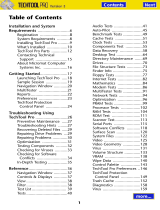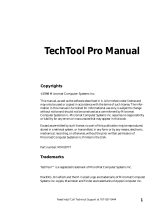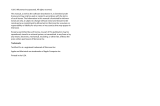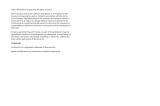Page is loading ...

i

ii
It is important that you register Drive Scope if you require technical support or wish to be notied of updates and upgrades. Online
registration is the preferred way to register. It immediately places your information into our user base and saves you the inconve-
nience of lling out, stamping, and mailing in the registration. If you purchased Drive Scope from micromat.com, you are automati-
cally registered.
Drive Scope Registration
To register online go to:
http://www.micromat.com
Micromat Inc.
5803 Skylane Blvd.
Suite C
Windsor, CA 95492

iii
©2017 Micromat Incorporated. All rights reserved.
This manual, as well as the software described in it,
is furnished under license and may only be used or
copied in accordance with the terms of such license.
The information in this manual is furnished for
informational use only, is subject to change without
notice and should not be construed as a commit-
ment by Micromat Inc. Micromat assumes no re-
sponsibility or liability for any errors or inaccuracies
that may appear in this book.
Except as permitted by such license, no part of this
publication may be reproduced, stored in a retrieval
system, or transmitted, in any form or by any means,
electronic, mechanical, recording, or otherwise,
without the prior written permission
of Micromat Inc.

iv
About Drive Scope ............................................................... 1
Getting Started...................................................................... 3
System Requirements ................................................................ 3
Installation .....................................................................................3
Using Drive Scope ................................................................ 4
The Drive Scope Interface ........................................................4
Information ..............................................................................................5
Attributes ..................................................................................................6
Capabilities...............................................................................................8
Self-Test .....................................................................................................9
SMART Logs ..........................................................................................11
Menus and Preferences ...........................................................12
SMART Attribute Glossary ............................................... 14
Frequently Asked Questions ..........................................39
Contacting Technical Support ....................................... 42
About Micromat Inc...........................................................43
Table of Contents

v

1
About Drive Scope
Drive Scope is an advanced SMART utility for the
Apple Macintosh. SMART (or S.M.A.R.T.) is an acro-
nym which stands for Self Monitoring Analysis and
Reporting Technology.
This technology was developed through the eorts
of the SMART Working Group (SWG), a consortium
of major hard disk manufacturers, to increase the
reliability of hard drives. SMART routines are now
incorporated into most new hard disk and solid
state drives. Although the SMART specication was
developed by the SWG, each drive manufacturer
uses their own proprietary routines in their drives.
The routines monitor important drive parameters as
a drive operates and stores the results in the drive’s
SMART registry. An examination and analysis of
these parameters can aid in the prediction of drive
failure. This could provide the warning you need
to back up your data and repair or replace a drive
before it fails. It is estimated that SMART monitoring
can predict 70% of drive hardware failures before
they occur.
SMART technology monitors a drive as it is used
and looks for unusual behavior. In rotational drives,
the routines keep track of disk performance, bad
sectors, calibration, CRC (data) errors, disk spin-up
time, distance between the head and the disk, tem-
perature, features of the media, heads, motor and
servomechanism. For example, motor or bearing
failure can be predicted by an increase in the drive
spin-up time and the number of retries required
to spin-up the drive. Excessive use of error correc-
tion routines could indicate a broken drive head or
contamination on the head. Spotting these types of
errors early may prevent future catastrophe.

2
SMART Technology continues to be utilized for Solid
State Drives (SSDs). Because SMART originated on
rotational drives, some attributes (such as spin-
up count) are unused or set to static values, while
others have been added to keep track of potential
failures specic to solid state technology, such as
wear leveling.
The SMART specication also includes drive self-test
routines that can be executed to verify that a drive
is able to accurately read and write data. Drive
Scope includes functionality to execute a self-test
on a drive as well as check on the results stored its
SMART registry. Problems found in either of these
areas can indicate possible impending drive failure.
This advance notice can provide enough time to
back up your data before it becomes inaccessible.

3
Getting Started
System Requirements
• AMacintoshcapableofrunningOSX10.8.5orlater
• 2GBRAMorhigherrecommended
(Specications subject to change without notice.)
Installation
Drive Scope is a self-contained application which
does not require a traditional installer application.
To install, simply drag the application icon to the
Applications folder. Running the Drive Scope ap-
plication will install a couple of extra les:
~/Library/Application Support/Drive Scope
~/Library/Preferences/com.micromat.Drive-
Scope.plist
An uninstall application is included to remove the
extra les created by running Drive Scope. To unin-
stall, simply double-click the uninstall application
icon.

4
Using Drive Scope
The Drive Scope Interface
Drive Scope runs from an installation on your hard
drive. To launch the program, double-click the Drive
Scope icon. After the program has launched, you
will see the main Drive Scope window.
The window contains a table listing available
SMART enabled drives, and a series of tabs which
separate the functions available for each SMART
enabled drive.
Drive Scope

5
Information
The information tab provides an overview of a
drive’s hardware information, capacity, and current
overall SMART status. Each data point is gathered
directly from the drive and displayed beside a
graphic of the drive and the manufacturer logo.
If the drive does not provide a particular piece of
information a “-” is displayed. The data points pro-
vided include:
Device Model: Drive model number
Model Family: Designation of the group of drives
the model belongs to (if available)
LU WWN Device Id: Logical Unit Worldwide Device
identier (if available)
Serial Number: The serial number of the drive
Firmware Version: Current rmware version in-
stalled on the drive
Type: Type of drive, such as SSD (solid state) or
HDD (rotational) - may include form factor and/or
rotational speed
Capacity: Total formatted drive size
Partition Map: Partition map scheme in use on the
drive
Sector Sizes: Bytes used per sector by data - lists
logical and physical values
Connection Bus: Bus used to connect the drive, i.e.
Internal SATA
ATA Version: ATA version information provided by
the drive
SATA Version: SATA version information provided
by the drive
Power On Hours: Time that the drive has been
powered on

6
Temperature: Current drive temperature
ATA Error Count: The count of all the errors the
drive has encountered for the lifetime of the drive
CRC Error Count: The count of uncorrectable errors
encountered when transfering data across the in-
terface, i.e. the drive cables and connectors. Derived
from SMART attribute 199 - see Glossary.
Health: Overall health of the device, as determined
by SMART attributes. Possible values are Passed,
Warning, and Failed. The warning state means that
a SMART attribute classied as ‘critical’ is in a pre-fail
state, and that the drive as a whole may soon enter
a Failed state.
Attributes
The Attributes tab lists the attributes reported by
the drive, along with the values reported for that
attribute. Note that the attribute data is presented
exactly as it is gathered from the drive, not inter-
preted by the software.
NOTE: The rst 13 attribute ID numbers are stan-
dardized, and are consistent across the majority of
drives (though not all of the rst 13 attributes are
always implemented). Attributes with ID numbers
higher than thirteen may be implemented dier-
ently amongst various manufacturers.
The table column descriptions are below; descrip-

7
tions for the attributes themselves can be found in
the glossary.
ID #: Identication number for the attribute
Attribute Name: Descriptive name of the SMART
attribute
Value: Normalized value, used to compare with
failure threshold (see below)
Worst: Lowest (or worst) value recorded for the
attribute
Threshold: Point below which the value will trigger
a SMART failure (on certain attributes)
Type: Attribute type is either Old Age or Pre-fail. Old
Age attributes report when the drive has exceeded
its designed life span, but may continue to operate,
whereas Pre-fail attributes tend to be unrelated to
drive age. When a pre-fail attribute reports failure,
this typically means that total drive failure is im-
minent.
Updated: An Always value means that this at-
tribute is checked continuously. An Oine value
means that drive monitors this attribute when in an
‘oine’ mode, when reads or writes are not occur-
ring.
When Failed: A Never value indicates that this at-
tribute has never reported failure. Failing Now indi-
cates that a failure is currently being reported. In the
past indicates that the attribute had fallen below
the threshold value in the past, but is now reporting
an above-threshold value. In the past is most often
used for temperature related attributes.
Raw Value: The actual value stored on the drive for
a given attribute. Depending on the attribute, the
value may or may not be human-readable.
Min: If the attribute stores minimum and maximum
values, the minimum is stored here.

8
Max: If the attribute stores minimum and maxi-
mum values, the maximum is stored here.
NOTE: Drive manufacturers may be inconsistent in
their implementation of SMART attributes. The glos-
sary contains the available details of each SMART
attribute, but the actual implementation on a given
drive may vary from the available documentation.
Capabilities
The Capabilities tab lists the capabilities of the se-
lected drive. Available capabilities will have a check
mark icon next to them, while those capabilities
without a check mark are unavailable for that drive.
Oine Data Collection Status: SMART attribute
data may be collected when the disk is idle or while
the disk is in use. If the SMART data has ever been
collected while the disk is idle, the Oine Data Dol-
lection Status will be listed as Completed. If SMART
data has only been collected while the drive is ac-
tive, the status will be Never Started.
Oine Data Collection Duration (sec): If SMART
data has been gathered while the disk is idle, this is

9
the time taken for disk to collect data.
SMART Overall Health Self-Assessment: Reports
passed or failed. The Overall Health Self-Assess-
ment is the overall SMART result reported by many
utilities, such as Apple’s Disk Utility.
Self Test
The Self Test tab lists the drive’s stored test results
and provides an interface for running the drive’s
internal test routines manually.
SMART enabled drives save the 21 most recent test
results, and the Self Test tab lists those results in a
table. The table elds are as follows:
Number: The order of the test in the list. The most
recent are listed rst.
Test Description: The name of the test that was run.
Typically will be either Short oine or Extended
oine.
Status: A description of the result of the test. The re-
sult includes the percentage success, and whether
the test was aborted.
Lifetime (Hours): Records the number of hours of
operation that have progressed when the test is
run. The result can be inconsistent for solid state
drives.
LBA of First Error: Lists the Logical Block Address
(LBA) of the rst error encountered during testing. If
no errors are found, the eld is left blank.

10
Self Test Select
The Self-Test tab also includes controls to manually
initiate the SMART testing built into the drive. The
drop down menu allows choosing between the
Short and Extended oine tests. Clicking Start will
begin the chosen test. During testing, the Cancel
button will be available to stop the test, and the
current progress will be shown. At the conclusion of
the test, the result will be added to the test results
table described above.
Short Oine:
This self-test usually takes about two minutes to
complete. Its purpose is to conrm the read per-
formance of the drive and to quickly identify any
possible drive issues. For rotational drives, it con-
rms the electrical and mechanical performance.
Electrical checks may include tests of the read/write
circuitry, a test of the read/write heads, and a check
of buer RAM. Mechanical checks include seeking
and servo on data tracks as well as scanning small
parts of the drive’s surface (area is vendor-specic
and there is a time limit on the test). Lastly, it checks
the list of pending blocks (or sectors) that may have
read errors.
Extended oine:
Sometimes referred to as the Long oine self-test,
this self-test is a much more comprehensive and
thorough version of the Short self-test. Unlike the
Short self-test which only takes about two minutes
to complete, the Extended oine test usually will
take several hours, depending on the read/write
speed of the drive and its size. The Extended oine
self-test can also conrm the result of the Short self-
test since the time constraint may not adequately
supply sucient testing time to identify a potential

11
drive issue.
NOTE: Running a self-test is completely safe and
will not cause damage to the selected drive or
any of its data. Self-tests can be performed during
normal operation. However, running a self-test may
reduce performance of the drive while testing is in
progress. Self-tests will take longer to complete if
the drive is busy.
SMART Logs
The SMART Logs tab contains two tables. The rst
lists the device logs, the second error logs. The logs
are utilized by the SMART system as implemented
by the drive manufacturer, and are not human read-
able, but their titles can be used to gain insight into
the SMART activity on the drive.
NOTE: Some drive manufacturers may not enable
SMART logging, so one or both tables may be blank.
Device Logs
There are three device log columns: Address, Pages
and Log Name. The name describes the data in
the associated log. Each log name has an associ-
ated numeric value that is the log address. The log
address is used by the drive to access a specic log.
Each log is composed of one or more “pages.” Each
page consists of data stored by the drive for that
particular log. Some logs can have multiple pages,
while others will have no more than one page. The

12
logs themselves are used internally by the device
and are not human-readable.
Error Logs
The Error Log table will only contain data if errors
have been found. The error log will store the ve
most recent errors, if any errors are present. The er-
ror log has the following columns.
Number: Number (1-5) of the most recent error
Feature: Lists the type of error
Prior Command: The command issued prior to the
error being detected
LBA: Logical Block Address of the error
Power Up Time: The number of hours the drive has
been in use at the time the error is detected
Menus and Preferences
Drive Scope uses many of the standard menu items.
Additional menu items and items that dier from
their normal usage are listed below.
Drive Scope Menu
The Drive Scope menu includes several menu items
to access addtional functionality within the pro-
gram. Choosing Check for Updates... causes Drive
Scope to check for a newer version. If one is found,
Drive Scope oers to download the update.
The Install SAT SMART Driver... menu item allows
installation of a third-party driver to allow reading
SMART data from USB and FireWire connected hard
drives. (See FAQ for more information.)
The Preferences... menu item opens a preferences
pane that provides the option to customize which
attributes trigger a critical failure for a connected

13
drive.
File Menu
The File Menu includes a Save as PDF... menu item
to save the SMART data of the selected disk to a
PDF. The PDF contains data from each of the Drive
Scope tabs to an individual PDF page.
View Menu
The view menu has ve options, one for each tab.
In addition to choosing tabs directly, changing tabs
can also be accomplished from this menu.
Drives Menu
The Drives Menu has two menu items, Rescan
Drives and Update SMART Info. The Rescan Drives
menu item causes Drive Scope to scan for SMART
enabled drives.
Update SMART Info reloads the SMART data for the
selected drive.

14
SMART Attribute Glossary
Raw Value
Raw data reported by a SMART attribute. The raw
value may not be human readable. For example, the
‘Reallocated Sector Count’, typically reports the ac-
tual number of reallocated sectors. Other attributes
report values that can only be parsed by the device.
Type
The type of a SMART attribute. Either Pre-Fail for
attributes are said to indicator impending failure, or
“Old Age/Advisory” for attributes that just indicate
wear and tear. Note that one and the same attribute
can be classied as “Pre-Fail” by one manufacturer
or for one model and as “Old Age/Advisory” by
another manufacturer or for another model.
Updated
Indicates whether a particular SMART attribute is
updated all the time (Always) or only updated when
the device temporarily slows down disk read/write
activity (Oine).
State
The condition of a particular attribute at a given
time.
Threshold
Value below which a SMART attribute can trigger
a failure. Once the value is reached the attribute
“Fails”.
NOTE: Not all SMART attributes are Pre-Fail attri-
butes. The threshold below which the normalized
value will be considered “exceeding specications”.
If the SMART attribute type is Pre-Fail, this indicates
that SMART thinks the disk is approaching failure.
Exceeding the threshold value on a Pre-Fail at-
tribute will trigger “SMART impending failure” or
similar status.

15
Value
The current normalized value for the attribute.
Worst
The worst normalized value ever detected. 1 gener-
ally is worst, 253 best.
S.M.A.R.T Attributes
Attribute 1 - Raw Read Error Rate
Lower Raw Value is better
Reports the rate of hardware read errors that occur
when reading data from a disk surface. The raw
value has a dierent structure for dierent vendors
and is often not meaningful as a decimal number. If
this SMART attribute reports a failure, it could be an
indication of a problem with the the disk surface or
with the read/write heads of the hard drive.
Attribute 2 - Throughput Performance
General throughput performance of a hard drive.
If a failure is reported for this SMART attribute,
this would indicate a problem with the hard drive
motor, servo or bearings. If the raw value of this
SMART attribute is decreasing there is a high prob-
ability that there is a problem with the hard drive.
Attribute 3 - Spin-Up Time
Lower Raw Value is better
Reports the time required (in seconds or millisec-
onds) for the spindle of a rotational hard drive to
spin up to operational speed. Typically, spin up oc-
curs during while the computer is starting up.
Most modern computers feature the ability to spin
down the drive while running in energy saving or
noise reduction mode. A decline of this attribute
can indicate that the drive may not be getting ad-
equate power (which is somewhat common in en-
/









